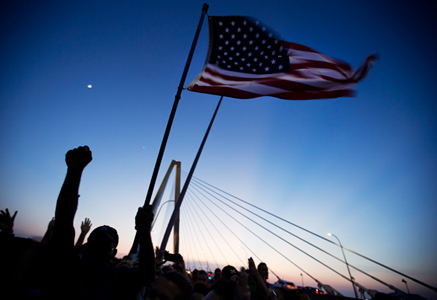
CHARLESTON, S.C. — Calls to remove the Confederate flag from the grounds of South Carolina’s statehouse grew on Monday, in the aftermath of the murder of nine African American worshippers including pastor and state Sen. Clementa Pinckney at the city’s historic Emanuel African Methodist Episcopal Church. The Confederate flag features prominently in photos of the white youth Dylann Storm Roof, 21, arrested and charged with the murders.
Political and religious leaders including Joseph P. Riley Jr., Charleston’s Democratic mayor, said they would hold a rally at the capitol on Tuesday at 2 p.m. to push for the flag’s immediate removal.
Charleston Mayor Riley and North Charleston Mayor Keith Summey, both of whom are white, were joined by state lawmakers, Rev. Joe Darby of the NAACP, and others at a news conference at North Charleston City Hall, calling for state leaders to take action. Calling the flag Roof’s “symbol,” Riley said, “The time has come for the flag to be removed from the statehouse grounds.”
State Sen. Marlon Kimpson, grandson of a sharecropper, told reporters there is “a growing chorus” of South Carolina senators who are interested in seeing legislation passed to remove the Confederate flag before the current session ends.
Meanwhile, South Carolina’s Republican state leaders held a flurry of phone meetings to figure out where they stand. Gov. Nikki Haley, a far-right Republican who has until now favored leaving the flag where it is, was meeting with lawmakers ahead of a news conference announced for Monday afternoon. She is reportedly “formulating a plan” to remove the flag from its current location.
“Last week’s terrorizing act of violence shook the very core of every South Carolinian,” Republican state House Majority Leader Jay Lucas said in a statement. “Moving South Carolina forward from this terrible tragedy requires a swift resolution of this issue.”
The Republicans who have led South Carolina for a quarter-century have rebuffed many previous calls to remove the flag, and there’s no apparent consensus between them on how they should respond now. The last governor to call for removing the flag was swiftly voted out of office.
A political compromise in 2000 moved it from the top of the Capitol dome to a Confederate monument out front, in a deal that also made it very difficult to make any other changes: A super-majority of two-thirds of both houses is required.
That compromise is one reason why the flag has continued to fly high outside the statehouse since the shooting, even as state and U.S. flags were lowered to half-staff. The symbolism of this has angered many people, particularly after photos surfaced of Dylann Storm Roof burning one American flag and stepping on another, while waving and posing provocatively with Confederate banners.
It also means that when the state aims to honor Emanuel’s slain senior pastor, state Sen. Clementa Pinckney, who served among the lawmakers for 19 years, thousands of people might walk past the flag as they come to see his coffin.
At least one Republican said he wasn’t courageous enough to take a stand before, but the shootings changed that.
“I just didn’t have the balls for five years to do it,” said state Rep. Doug Brannon, who was elected in 2010.
“When my friend was assassinated for being nothing more than a black man, I decided it was time for that thing to be off the Statehouse grounds,” Brannon said. “It’s not just a symbol of hate, it’s actually a symbol of pride in one’s hatred.”
The debate over the flag has been revived as thousands of people converged on Charleston to show their solidarity with the victims and join a mix of rallies, marches and funerals.
Bells tolled across Charleston Sunday as thousands linked up on a towering bridge and the Emanuel African Methodist Episcopal Church reopened in displays of unity. Many people spoke about love and repudiated racism at the remembrances, hopeful their expressions would drown out the hate that the shooter hoped to generate.
“It sends a message to every demon in hell and on earth,” said the Rev. Norvel Goff, who led the first Sunday service since the killings at the historic church known as “Mother Emanuel.”
Later Sunday, thousands marched on the city’s iconic Arthur Ravenel Jr. Bridge, a 2-mile span with towering cable supports, and dozens of boats maneuvered underneath, blowing their air horns in support.
When the marchers from the two sides met near the middle, they cheered, clapped and broke into songs including “This Little Light of Mine.”
The bridge is named after a former state lawmaker and vocal Confederate flag supporter, one of many symbols of white power that remain in South Carolina and can’t easily be changed because of the flag deal.
Less than 2 miles from Emanuel, someone vandalized a Confederate monument, spray-painting “Black Lives Matter” on the statue. City workers used a tarp to cover up the bright red paint, which also included the message “This is the problem. (hash) RACIST.”
State Rep. Wendell Gilliard, a steelworker and leader of USW Local 863, predicted that Haley would have to take the flag down from the Statehouse. Gilliard told the Monday press conference, “I can stand here like these ladies and gentlemen who have been a part of this movement in the state of South Carolina and had to endure a lot, I can stand here today and tell you, she is going to change her mind. She is going to change her mind and that flag will come down.”
“And when the flag comes down, then and only then it will be a great day in the state of South Carolina.”
The Associated Press contributed to this story. Other sources include Live 5 WCSC.
Photo: People hold an American flag as thousands march on Charleston’s main bridge in a show of unity, Sunday, June 21, 2015, after nine black church parishioners were gunned down during Bible study on June 17, in Charleston, S.C. (David Goldman/AP)










